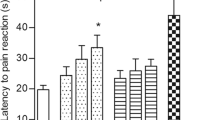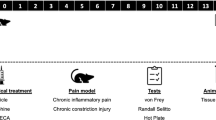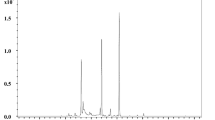Abstract
The temporal activation of the sensory systems, especially in pain, determines intermediate states that define the future of the response to sensory stimulation. In this work, we interfere pharmacologically with those states that produce peripheral and central sensitisation after an acute inflammatory process, inhibiting at the periphery the COX-2 with celecoxib and using taurine (glycine A receptor agonist) for central pain relief. We tested the paw withdrawal reflex latencies to thermo- and mechanonociception after the induction of an acute inflammatory process with carrageenan. Celecoxib at low doses [0.13 and 1.3 mg/kg, intraperitoneal (i.p.)] in combination with taurine (300 mg/kg, i.p.) produces a decrease of the nociceptive response in thermo- and mechanonociception, as compared with the effect of both drugs alone. We propose that the enhancement of the analgesic effect of celecoxib in combination with taurine could be due the simultaneous action of these drugs at both, peripheral and central levels.





Similar content being viewed by others
REFERENCES
Sandkuhler, J. 1996. Neurobiology of spinal nociception: new concepts. Progress in Brain Research 110: 207–224.
Cervero, F., and J.M. Laird. 1996. From acute to chronic pain: mechanisms and hypotheses. Progress in Brain Research 110: 3–15.
Woolf, C.J., and M. Costigan. 1999. Transcriptional and posttranslational plasticity and the generation of inflammatory pain. Proceedings of the National Academy of Sciences of the United States of America 96: 7723–7730.
Latremoliere, A., and C.J. Woolf. 2009. Central sensitization: a generator of pain hypersensitivity by central neural plasticity. The Journal of Pain 10: 895–926.
Telleria-Diaz, A., M. Schmidt, S. Kreusch, A.K. Neubert, F. Schache, E. Vazquez, H. Vanegas, H.G. Schaible, and A. Ebersberger. 2010. Spinal antinociceptive effects of cyclooxygenase inhibition during inflammation: Involvement of prostaglandins and endocannabinoids. Pain 148: 26–35.
Rezende, R.M., W.G. Dos Reis, I.D. Duarte, P.P. Lima, Y.S. Bakhle, and J.N. de Francischi. 2009. The analgesic actions of centrally administered celecoxib are mediated by endogenous opioids. Pain 142: 94–100.
Yan, L.H., J.F. Hou, M.G. Liu, M.M. Li, X.Y. Cui, Z.M. Lu, F.K. Zhang, Y.Y. An, L. Shi, and J. Chen. 2009. Imbalance between excitatory and inhibitory amino acids at spinal level is associated with maintenance of persistent pain-related behaviors. Pharmacological Research: The Official Journal of the Italian Pharmacological Society 59: 290–299.
Ye, G., A.C. Tse, and W. Yung. 1997. Taurine inhibits rat substantia nigra pars reticulata neurons by activation of GABA- and glycine-linked chloride conductance. Brain Research 749: 175–179.
Chattipakorn, S.C., and L.L. McMahon. 2003. Strychnine-sensitive glycine receptors depress hyperexcitability in rat dentate gyrus. Journal of Neurophysiology 89: 1339–1342.
Mori, M., B.H. Gahwiler, and U. Gerber. 2002. Beta-alanine and taurine as endogenous agonists at glycine receptors in rat hippocampus in vitro. The Journal of Physiology 539: 191–200.
Jiang, Z., K. Krnjevic, F. Wang, and J.H. Ye. 2004. Taurine activates strychnine-sensitive glycine receptors in neurons freshly isolated from nucleus accumbens of young rats. Journal of Neurophysiology 91: 248–257.
Lim, E.S., and I.O. Lee. 2010. Effect of intrathecal glycine and related amino acids on the allodynia and hyperalgesic action of strychnine or bicuculline in mice. Korean Journal of Anesthesiology 58: 76–86.
Belfer, I., E. Davidson, A. Ratner, E. Beery, Y. Shir, and Z. Seltzer. 1998. Dietary supplementation with the inhibitory amino acid taurine suppresses autotomy in HA rats. Neuroreport 9: 3103–3107.
Serrano, J.S., M.I. Serrano, M.R. Guerrero, R. Ruiz, and J. Polo. 1990. Antinociceptive effect of taurine and its inhibition by naxolone. General Pharmacology 21: 333–336.
Pellicer, F., A. Lopez-Avila, U. Coffeen, J. Manuel Ortega-Legaspi, and R.D. Angel. 2007. Taurine in the anterior cingulate cortex diminishes neuropathic nociception: a possible interaction with the glycine(A) receptor. European Journal of Pain 11: 444–451.
Zimmermann, M. 1983. Ethical guidelines for investigations of experimental pain in conscious animals. Pain 16: 109–110.
Lopez-Avila, A., G. Rodriguez-Manzo, U. Coffeen, R. del Angel, and F. Pellicer. 2004. Self-injury behaviour induced by intraplantar carrageenan infiltration: a model of tonic nociception. Brain Research. Brain Research Protocols 13: 37–44.
Werner, U., D. Werner, A. Pahl, R. Mundkowski, M. Gillich, and K. Brune. 2002. Investigation of the pharmacokinetics of celecoxib by liquid chromatography-mass spectrometry. Biomedical Chromatography: BMC 16: 56–60.
Ghandforoush-Sattari, M., S. Mashayekhi, C.V. Krishna, J.P. Thompson, and P.A. Routledge. 2010. Pharmacokinetics of oral taurine in healthy volunteers. Journal of Amino Acids 2010: 346237.
Paulson, S.K., J.Y. Zhang, S.M. Jessen, Y. Lawal, N.W. Liu, C.M. Dudkowski, Y.F. Wang, M. Chang, D. Yang, J.W. Findlay, M.A. Berge, C.S. Markos, A.P. Breau, J.D. Hribar, and J. Yuan. 2000. Comparison of celecoxib metabolism and excretion in mouse, rabbit, dog, cynomolgus monkey and rhesus monkey. Xenobiotica; The Fate of Foreign Compounds in Biological Systems 30: 731–744.
Ishikawa, T., M. Marsala, T. Sakabe, and T.L. Yaksh. 2000. Characterization of spinal amino acid release and touch-evoked allodynia produced by spinal glycine or GABA(A) receptor antagonist. Neuroscience 95: 781–786.
Legendre, P. 2001. The glycinergic inhibitory synapse. Cellular and Molecular Life Sciences: CMLS 58: 760–793.
Hara, K., M. Nakamura, Y. Haranishi, T. Terada, K. Kataoka, and T. Sata. 2012. Antinociceptive effect of intrathecal administration of hypotaurine in rat models of inflammatory and neuropathic pain. Amino Acids 43: 397–404.
Shin, M.C., M.H. Jang, H.K. Chang, Y.J. Kim, E.H. Kim, and C.J. Kim. 2003. Modulation of cyclooxygenase-2 on glycine- and glutamate-induced ion currents in rat periaqueductal gray neurons. Brain Research Bulletin 59: 251–256.
Marcinkiewicz, J. and E. Kontny. 2012. Taurine and inflammatory diseases. Amino Acids (in press).
Savage, R. 2005. Cyclo-oxygenase-2 inhibitors: when should they be used in the elderly? Drugs & Aging 22: 185–200.
Risser, A., D. Donovan, J. Heintzman, and T. Page. 2009. NSAID prescribing precautions. American Family Physician 80: 1371–1378.
ACKNOWLEDGEMENTS
This project was partially supported by the CONACyT grant 62433 for FP and the INPRF grant 3230 and the scholarship for community service in research, Secretaría de Salud, México, for Beatriz de Rienzo-Madero, Universidad Panamericana School of Medicine.
Conflict of Interest
The authors declare that they have no conflict of interest.
Author information
Authors and Affiliations
Corresponding author
Rights and permissions
About this article
Cite this article
de Rienzo-Madero, B., Coffeen, U., Simón-Arceo, K. et al. Taurine Enhances Antinociception Produced by a COX-2 Inhibitor in an Inflammatory Pain Model. Inflammation 36, 658–664 (2013). https://doi.org/10.1007/s10753-012-9589-4
Published:
Issue Date:
DOI: https://doi.org/10.1007/s10753-012-9589-4




